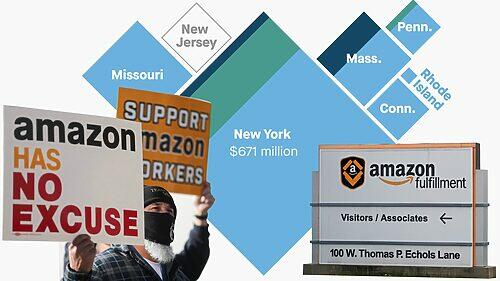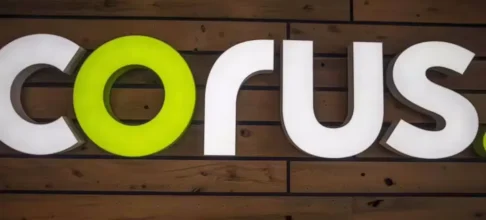Amazon, a trillon-dollar company, has received at least $5 billion in US-based tax breaks and other subsidies, according to data from Good Jobs First, a nonprofit that finds and tracks agreements between the company and state and local governments.
“The $5.1 billion is only the tip of the iceberg, because there’s more money that we just don’t know about,” said Kasia Tarczynska, a senior research analyst at Good Jobs First. Since Amazon isn’t required to disclose this information, researchers only know about the subsidies they can find in public documents and the media.
These data highlight an issue at the heart of the Make Amazon Pay campaign, which aims to draw attention to Amazon’s poor record on workers’ rights, climate change, and tax avoidance. Good Jobs First is a member of the international coalition of organizations coordinating the movement.
Offering tax breaks and incentives to attract business is common practice for state and city governments. Politicians want thriving local economies and jobs for their communities. In the US, these kinds of subsidies amount to at least $30 billion annually.
But recent research from Princeton didn’t find strong evidence that company-specific tax incentives increased broader economic growth. And companies such as Amazon would, more often than not, move to locations regardless of such incentives, another study suggested.
The subsidies Amazon has received in the US
Most of Amazon’s US subsidies were for distribution centers—52%, or $2.7 billion. A further 31% were for offices, and 11% were provided for data centers.
“Amazon gets subsidies for all sorts of different activities. The majority of the subsidies are for warehouses, but every single activity the company does is being subsidized,” said Tarczynska. “A huge amount of tax breaks go to data centers; Amazon receives tax breaks for movie production—making movies for its Prime streaming services; it gets money for its [subsidiary] Whole Food stores, etc.”

In total, 38 states have doled out breaks for Amazon. The most significant amounts have come from Virginia ($824 million) and Illinois ($732 million). The vast majority of Virginia’s incentives and tax breaks were for Amazon’s second US headquarters, HQ2. In 2017, Amazon asked for subsidy proposals from state and local governments to set up HQ2—in effect, asking them to bid against each other to woo the company. Cities in Canada, Mexico, and the US made offerswith Virginia ultimately winning the bid.

The US is not alone in offering significant tax breaks and incentives for Amazon. However, such data are difficult to find overseas. So far, Good Jobs First has discovered at least half a billion dollars in public funding for Amazon projects (pdf) in other countries.
What is Make Amazon Pay?
The Make Amazon Pay campaign launched in 2020, and on Black Friday every year, it calls for Amazon’s workers to strike and for shoppers to protest and boycott the company. This year, Amazon warehouse workers in about 40 countries are expected to participate in protests and walkouts.
“We want legislation that stops the Amazon-ification of our economies and our societies,” said Clare Carlile, a writer and researcher at Ethical Consumerwhich offers readers guidance on ethical shopping and is another participating organization in Make Amazon Pay. “We’re saying Amazon needs to step up and pay its dues with respect to climate change and communities, but we’re also saying legislators and policymakers need to be looking at their exploitation, recognizing that we need to do something different.”
The campaign has a considerable remit: It aims to tackle Amazon’s carbon footprint, its history of union-busting and poor working conditionsits impact on communitiesand its significant tax avoidance.
“To me, the most important thing to focus on is the interconnection between all these different issues. It’s really important that we’re drawing links between things like tax avoidance and the impact on communities and the damage to the environment,” said Carlile. “All these things are interlinked in Amazon’s race to the bottom. That, for me, is what Make Amazon Pay is about.”
When asked about the campaign’s claim that “instead of supporting its workers, communities and the planet, Amazon is squeezing every last drop it can,” a spokesperson from Amazon responded: “These groups represent a variety of interests, and while we are not perfect in any area, if you objectively look at what Amazon is doing on these important matters you’ll see that we do take our role and our impact very seriously.”
Read More














